- Your Section 11.2 homework is returned:
- 16 -- part a; i and j are equivalent dummy indices; in part b,
is independent of i, and hence constant. The second sum is thus
- 20 -- this is a geometric series; compute c and r.
- 44 -- You're supposed to use the fact that the series "telescopes". If you didn't, why not?
- 16 -- part a; i and j are equivalent dummy indices; in part b,
- concerns several different means of testing for convergence of
series with all positive terms (obviously, if we're dealing with series
of all negative terms, similar results are going to apply).
- We're not so concerned with the actual limits (that is the values
of the series) as we are with the convergence (or divergence) of the
series.
- Theorems:


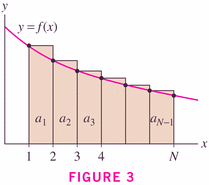
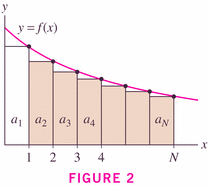
Theorem 3 is just a corollary of Theorem 2, where the integrals are the obvious power functions:

Let
, where f is a positive, decreasing function. If
converges by the integral test, and we define the remainder by
, then
(this gives us a bound on the error we're making in the calculation of a series). This is useful, for example, in the calculation of digits of
(now, you might ask "and what's the use of that?!";).
We can use this remainder inequality to get a bound on the true value of the series, just by adding
to each part of the inequality:
- Examples:
- We can use this method to demonstrate conclusively that the harmonic series is non-convergent.
- Dominoes (here's my page) -- and here's a more elegant page in Mathematica: Divergence of the harmonic series (and dominoes!)
- #22
- #36
- Theorems:
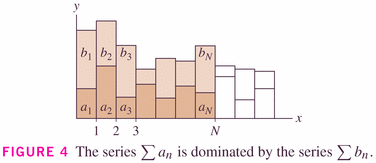
- if the series of the
if finite, so is the smaller series of
;
- if the series of the
if infinite, so is the larger series of
.

- geometric series, and
- p series, including
- the harmonic series (to show divergence).
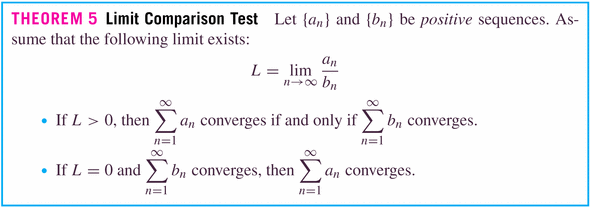
This theorem says that, in the long run, one series has terms which are simply a constant times the terms in the other series.
In "the long run" means that we only really need to worry about the "tails" of series: we can throw away any finite number of terms for issues of convergence.
- if the series of the
- Examples:
- #6, p. 750
- #16
- #28
- #34 (draw a picture)
- #46 (this is a cool argument -- pay attention!)
-
Once again, our mission here is not necessarily the value of the
series, but may be simply knowledge of whether it converges or
not.
- How does the author of this image reach the conclusion that "the sum is positive and at most
"?
- How about the partial sums --
-- what are they doing?
- What are the even partial sums doing?
- What are the odd partial sums doing?
- Examples:
- The alternating harmonic series is convergent
(Example 1, p. 753).
We need to show that the terms
of the series satisfy the Leibniz test:
- the terms are positive,
- the terms are decreasing in size,
- the terms have limit of 0.
- #5, p. 755
Identify the terms
, and decide whether they satisfy the Leibniz test.
- #13
- #17
Remember that for convergence, the conditions of the test need be true only eventually: convergence is all about the tail, not the head of the sequence.
- #23
For this one, we need the "Alternating Series Estimation Theorem" (p. 754):
- #27
- #34
- The alternating harmonic series is convergent
(Example 1, p. 753).
That being said, a theorem below does give us some help in determining the value of (or at least bounds on the value of) the series of a type called an "alternating" series. In particular, we want to look at alternating series like the one below:
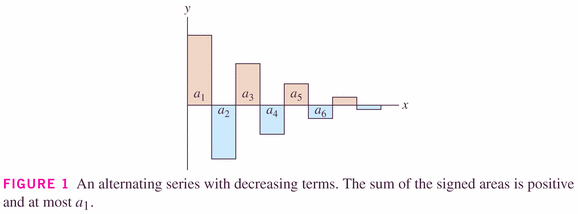
So it turns out that if the terms are converging to 0, then the alternating sequence converges to a limit.
Now we usually write our alternating series in the following way, illustrated by Leibniz's test: we assume that the are positive, and the term
takes care of the "alternation". (Our textbook switches to
for the positive part of the term.)
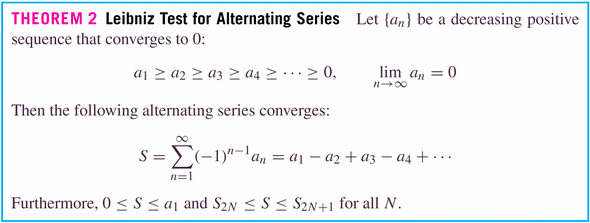
Our textbook calls this the "Alternating Series Test" (p. 751). The "Furthermore" part our textbook calls the "Alternating Series Estimation Theorem" (p. 754).